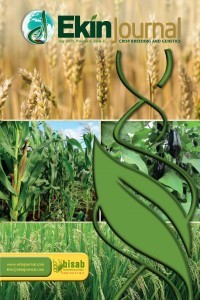Phenotypic Diversity among the Virginia Breeding Lines of Groundnut
Phenotypic Diversity among the Virginia Breeding Lines of Groundnut
___
- Azharudheen TPM and Gowda MVC, (2013). An assessment of prospects of developing confectionery grade genotypes with multiple disease resistance in groundnut (Arachis hypoageae L.). Inter J of Biotechn and Bioengineering Research 4:347-354
- Bhargavi G, Satyanarayana Rao V, Ratna Babu D and Narasimha Rao KL (2017). Genetic variability studies in Virginia bunch groundnut (Arachis hypogaea L.). Agric. Sci. Digest. 37(4): 310-313
- Burton GW and De vane EM (1953). Estimating heritability in tall fescue (Festuca arundinaceae) from replicated clonal material. Agron. J. 45: 479-481 Chiow HY and Wynne JC (1983). Heritabilities and genetic correlations for yield and quality traits of advanced generations in a cross of peanut. Peanut Sci. 37:13-17
- Coffelt A, Seaton ML and VanScoyoc SW (1989). Reproductive efficiency of 14 Virginia-type peanut cultivars. Crop Sci. 29:1217-1220
- Cox FR (1979). Effect of temperature treatment on peanut vegetative and fruit growth. Peanut Sci. 6(1): 14-17
- Dudhatra RS, Viradiya YA, Joshi KB, Desai TA, Vaghela GK (2022). Genetic divergence analysis in groundnut (Arachis hypogaea L.) genotypes. Emer Life Sci Res. 8(1):114-118. Groundnut Crop Survey Report, IOPEPC, 2019
- Erickson PI and Ketring DL (1985). Evaluation of genotypes for resistance to water stress in situ. Crop Sci. 25:870-876
- FAO of United Nation, FAOSTAT, (2020). https://www. fao.org/faostat/en/#data/QCL http://www.fao. org/faostat/en/#data/QC, (Accessed 5 July 2020)
- Gangadhara K, Dagla MC, Praveen Kona, Narendra Kumar, Ajay BC, Rathnakumar AL and Gor HK, (2019). Evaluation of large seeded groundnut advanced breeding lines for components of pod yield and water use efficiency. Int.J.Curr. Microbiol.App.Sci. 8(10): 835-844
- Gangadhara K, Rathnakumar AL, Praveen Kona, Ajay BC, Narendra Kumar, Sushmita and Gor HK, (2020). Evaluation of groundnut germplasm for pod yield and its attributes in summer J. Oilseeds Res. 37:39-40
- Golakia PR and Makne VG (1992). D2 analysis in Virginia runner groundnut genotypes Indian J. Genet. 52 (3): 252-256
- Gupta RP, Vachhani JH, Kachhadia VH, Vaddoria MA and Barad HR, (2015). Correlation and path analysis in Virginia groundnut (Arachis hypogaea L.) Electronic Journal of Plant Breeding 6(1):248-252
- ICRISAT (1992). Annual report. International Crop Research Institute for Semi arid Tropics, Patencheru, India
- Ikisan Agroinformatics and services, Groundnut, http:// ikisan.com/tn-groundnut-history.html (Accessed 28 August 2020)
- Johnson HW, Robinson HF and Comstock RE, (1955). Estimates of genetic and environmental variability in Soybean Agronomy J. 47:314-318
- Kalariya KA, Singh AL, Chakraborty K, Ajay BC, Zala PV, Patel CB, Nakar RN, Goswami N and Mehta D, (2017). SCMR: A more pertinent trait than SLA in peanut genotypes under transient water deficit stress during summer. Proc. Natl. Acad. Sci., India, Sect. B Biol. Sci. 87(2):579-589
- Krishna KR, (2010). Agro ecosystems of South India: Nutrient dynamics, ecology and productivity, Brown Walker Publishers, Bocaraton, Florida, USA
- Nigam SN, Nageswara Rao RC, Wynne JC, Williams M, Eitzner M and Nagabhushanam GVS, (1994). Effect and interaction of temperature and photoperiod on growth and partitioning in three groundnut (Arachis hypogaea L.) genotypes. Ann. App. Biol. 125:541-552
- Nigam SN, Nageswara Rao and Wynne JC, (1998). Effects of temperature and photoperiod on vegetative and reproductive growth of Groundnut (Arachis hypogaea L.) J Agron and Crop Sci. 181:117-124
- Robinson HF, Comstock RE and Harvey PH, (1949). Estimates of heritability and degree of dominance in corn. Agron. J. 41:353-359
- Saini H and Sharma MM, (2018). Genetic variability and character association study in a RIL population for yield and quality traits in groundnut (Arachis hypoagea L.). Inter. J. of chemical studies. 6(6):2179-2185 Shinde HN, More SR, Pawar SV, Amolic VL,
- Shinde GC and Nimbalkar CA (2019). Genetic divergence study for different traits in groundnut. J Pharmacognosy and Phytochemistry 8(5):1501- 1504
- ISSN: 2149-1275
- Yayın Aralığı: Yılda 2 Sayı
- Başlangıç: 2015
- Yayıncı: Bitki Islahçıları Alt Birliği
Registration of ‘’Yılmaz’’ Fiber Linen (Linum usitatissimum L.) Variety
Serkan YILMAZ, Arslan UZUN, Meral ERGİN, Mehmet ERDOĞMUŞ
Identification of Novel Five Variants of Caladium Species Through Multi-Environmental Evaluation
Mohan LAL, Joyashree BARUAH, Twahira BEGUM, Rose Laldinaii DARNEI, Jami NYITAN
Registration of "Yörem 55" Forage Legume (Trifolium meneghinianum Clementi) Variety
Necda ÇANKAYA, Kadir İSPİRLİ, Fatih ALAY, Muhammet ŞAHİN, Elif ŞAHİN, Fatih KUMBASAR
Ahmad Yar AHMADI, Mohammad Wali SALARI
Phenotypic Diversity of Red and White Onion Genetic Resources Collected from Different Countries
Arif BAĞCI, Ahmet BALKAYA, Dilek KANDEMİR, Onur KARAAĞAÇ
Registration of "Orak 22" Barley (Hordeum vulgare L.) Variety
Registration of "Harman 22" Bread Wheat (Triticum aestivum L.) Variety
Registrationof"Ki̇rve"BreadWheat(Triticum aestivum L.) Variety
Cemal ŞERMET, H.orhan BAYRAMOĞLU, Yavuz BALMUK, Nevzat AYDIN
Phenotypic Diversity among the Virginia Breeding Lines of Groundnut
